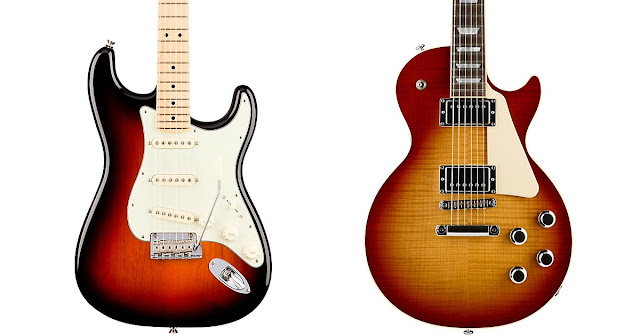Les Paul or Stratocaster: Which Guitar Is Right for You?
Ask the average person to describe or sketch an electric guitar and chances are they’ll come up with something that resembles either a Fender Stratocaster or Gibson Les Paul. These two guitars are imprinted on our collective consciousness for good reason.
Ever since their introductions in the 1950s, the Strat and the LP have largely ruled the electric guitar roost. Both offered revolutionary improvements in both playability and sonic performance. Each is a completely different and much-copied design; their tone and playing feel completely distinct.
Here’s a list of those differences:
Scale length
A big difference between the Stratocaster and the Les Paul is their scale length—the length of the strings measured from the nut to the bridge. The Les Paul is 24.75 inches versus the Stratocaster’s longer 25.5 inches. This has an impact on both sound and playability.
A longer scale length results in more space between the frets and greater string tension making it a little more challenging to play for smaller hands. Though string tension is greater, due to their additional length, the strings have a bit of”give." The Stratocaster’s longer scale results in a brighter, more chiming sound whereas the LP’s shorter scale is to an extent responsible for its rounder, warmer sound.
Pickup configuration
While Stratocasters and Les Pauls are available with a broad range of pickup configurations and switching options these days, their classic pickup arrays are another important way they’re different.
A traditional Stratocaster is equipped with three single-coil pickups (neck, middle, bridge). A traditional Les Paul has two humbucker pickups (neck and bridge).
Single-coil pickups tend to sound brighter and crisper and cut through dense band mixes. They’re also are prone to generating hum and other noise caused by electrical interference.
Humbuckers were designed to eliminate noise and they generally produce a thicker, deeper sound than single-coils. In very broad terms, single-coils lend themselves to blues, funk, surf and country styles. Humbuckers, on the other hand, are often used in hard rock, metal, blues and jazz styles. But there are no hard and fast rules–either pickup type can be used to play whatever you want. Tone is a very personal thing and both guitars are remarkably versatile.
Tailpiece/Bridge
The Stratocaster is equipped with a one-piece tailpiece/tremolo bridge with individually adjustable string saddles. This latter feature allows easier guitar setup when intonating strings.
While the Stratocaster’s tremolo bridge allows wild string-bending action, there is a downside: Such theatrics can pull your guitar's strings out of tune.
Most Les Pauls are equipped with Gibson’s Tune-o-matic fixed bridge that has two adjustable posts with a bar between them containing the individual string saddles. The strings then terminate at the so-called “stop bar” tailpiece. Most players give this setup high marks for staying in tune.
Which guitar’s right for you?
The LP and Strat are iconic for good reasons. Though they have very distinctive personalities and playing characteristics, they’re both incredibly versatile guitars. If you’re not sure, and you’ve got the budget, there’s nothing wrong with owning both!
Ever since their introductions in the 1950s, the Strat and the LP have largely ruled the electric guitar roost. Both offered revolutionary improvements in both playability and sonic performance. Each is a completely different and much-copied design; their tone and playing feel completely distinct.
Here’s a list of those differences:
Scale length
A big difference between the Stratocaster and the Les Paul is their scale length—the length of the strings measured from the nut to the bridge. The Les Paul is 24.75 inches versus the Stratocaster’s longer 25.5 inches. This has an impact on both sound and playability.
A longer scale length results in more space between the frets and greater string tension making it a little more challenging to play for smaller hands. Though string tension is greater, due to their additional length, the strings have a bit of”give." The Stratocaster’s longer scale results in a brighter, more chiming sound whereas the LP’s shorter scale is to an extent responsible for its rounder, warmer sound.
Pickup configuration
While Stratocasters and Les Pauls are available with a broad range of pickup configurations and switching options these days, their classic pickup arrays are another important way they’re different.
A traditional Stratocaster is equipped with three single-coil pickups (neck, middle, bridge). A traditional Les Paul has two humbucker pickups (neck and bridge).
Single-coil pickups tend to sound brighter and crisper and cut through dense band mixes. They’re also are prone to generating hum and other noise caused by electrical interference.
Humbuckers were designed to eliminate noise and they generally produce a thicker, deeper sound than single-coils. In very broad terms, single-coils lend themselves to blues, funk, surf and country styles. Humbuckers, on the other hand, are often used in hard rock, metal, blues and jazz styles. But there are no hard and fast rules–either pickup type can be used to play whatever you want. Tone is a very personal thing and both guitars are remarkably versatile.
Tailpiece/Bridge
The Stratocaster is equipped with a one-piece tailpiece/tremolo bridge with individually adjustable string saddles. This latter feature allows easier guitar setup when intonating strings.
While the Stratocaster’s tremolo bridge allows wild string-bending action, there is a downside: Such theatrics can pull your guitar's strings out of tune.
Most Les Pauls are equipped with Gibson’s Tune-o-matic fixed bridge that has two adjustable posts with a bar between them containing the individual string saddles. The strings then terminate at the so-called “stop bar” tailpiece. Most players give this setup high marks for staying in tune.
Which guitar’s right for you?
The LP and Strat are iconic for good reasons. Though they have very distinctive personalities and playing characteristics, they’re both incredibly versatile guitars. If you’re not sure, and you’ve got the budget, there’s nothing wrong with owning both!




Comments
Post a Comment